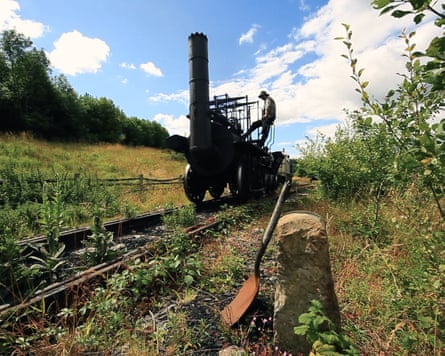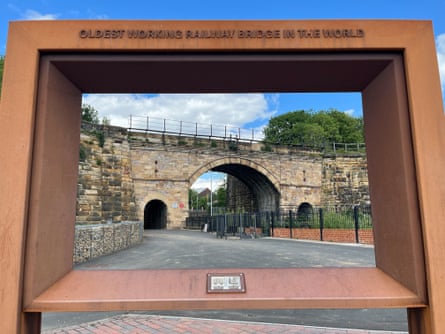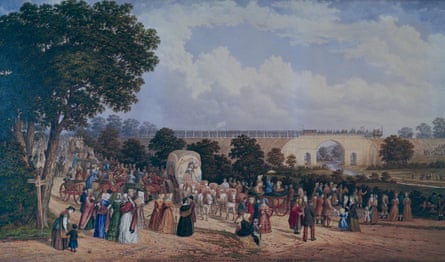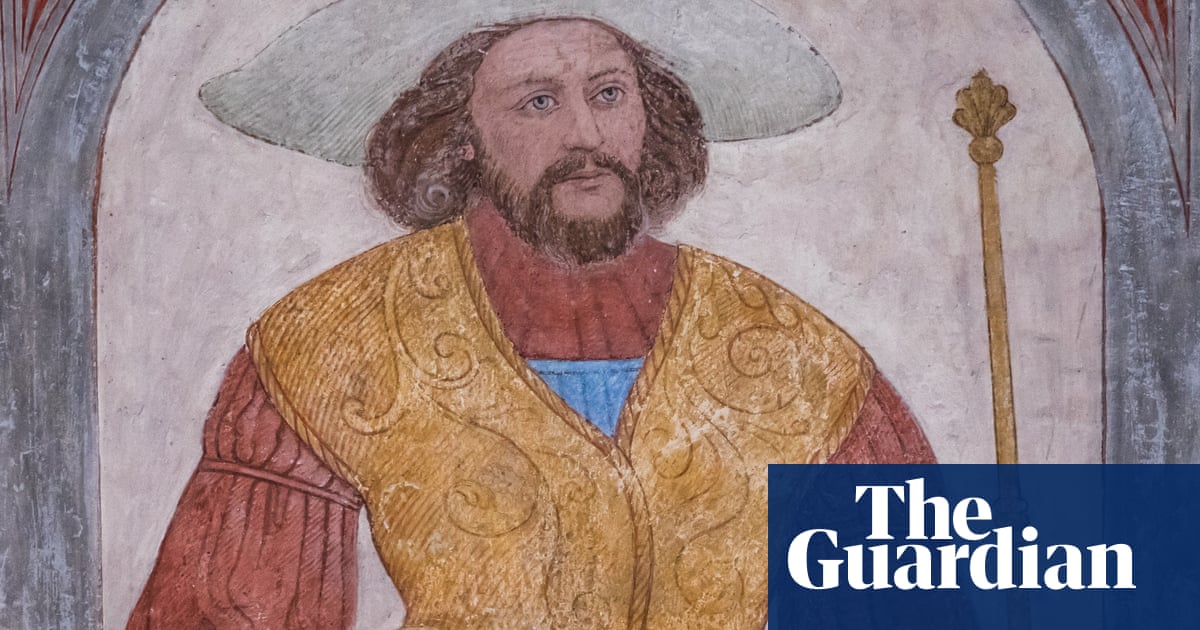It was as strange a sight as you could stumble upon in the English countryside. As a muggy summer’s day began outside Shildon, Durham – rain threatening, bees drowsy in the hedgerows – I found myself standing on an embankment, surveying two rows of colossal stone teeth jutting through the earth. It looked as if someone had buried a sleeping giant.
“You wouldn’t believe it by looking at it, but this is one of railway history’s most amazing feats,” my companion, rail expert Richie Starrs, said as we gazed down at the molars beneath our feet. A closer look revealed they were abandoned rail sleepers, laid out between the hawthorns and along which coal wagons were once pulled uphill by steam traction locomotives. “This is the Brusselton Incline, a section of the original Stockton and Darlington Railway. Nationally, it’s a story that’s not well known, but it’s one we’re rightly proud of.”
For those interested in such rail history, this is a year like no other. Two hundred years ago, on 27 September 1825, the 26-mile Stockton and Darlington Railway opened as the world’s first public railway, making Shildon the world’s first railway town. And the lessons learned there helped the north-east, then Britain, Europe and the world grasp the importance of rail travel, first for transporting coal and lime, then, decisively, for passengers. It is “the railway that got the world on track”.
A focal point of this year’s bicentennial celebrations throughout Britain (see Railway 200 for details on hundreds of events) is Durham’s new multi-use S&DR Trail of Discovery. Launching this month as part of the multi-arts S&DR200 festival, the meandering greenway follows the original 26-mile route from Witton Park Colliery near Bishop Auckland to Stockton Riverside and will, its founders hope, stimulate interest in the region’s rail history – and give a shot in the arm to the “left behind” pit communities along the way. There is a buoyant mood around the anniversary, but that doesn’t dispel the melancholy that has lingered over much of the rail line since the coalfields were exhausted and the Shildon Wagon Works, once described as “the jewel in British Rail’s crown”, was closed.

There would be some who find this all too trainspotterish, but not Starrs, S&DR200’s project manager, or Niall Hammond, volunteer chair of the Friends of the S&DR, both of whom joined me on the first completed section of the trail, a five-mile ramble from the Brusselton Incline to Heighington station, the world’s first train station, at Newton Aycliffe.
Over the coming months, the trail – rich in history – will be transformed with 17 information boards and newly commissioned art murals, plus a podcast and augmented reality game, devised to add colour. Fittingly, you can also hop on a train between many of the milestones along the route.
The idea, Niall told me, is to encourage travellers to walk, eat and stay on the trail for two to three days, but also spark wider regeneration for the area. According to the Ministry of Housing, Communities and Local Government, Durham remains one of the most deprived areas in England. “This is more than history for people who like rail tracks and iron,” he told me. “The whole point is to make it count for locals. We’re doing up buildings, cleaning up areas and showing why the world was changed from here. It’s urban regeneration in action.”

Once my eyes had learned to read the signs of rail history in the landscape, despite the absence of so much of it, it became easier to imagine how this tiny corner of Durham changed the world. Along a stretch of the reclaimed rail line through Shildon, impressions of former goods sheds, an iron warehouse, loading bays and an engine house appeared next to tired houses and an empty pub.
We passed a coaling drop, admiring the handsome brickwork arches and columns that once saw wooden chutes rapidly unload coal into hoppers and a row of railway workers’ cottages, now memorials to those who dedicated their lives to the tracks. There was no whiff of engine oil, only bluebells and primrose.
The newest part of Shildon’s compelling train story is at Locomotion, a museum that opened its £8m New Hall last year. It holds Europe’s largest indoor collection of historic locomotives (a mightily impressive 99 engines) and is the temporary home of a 150-year-old bronze statue of the great north-east rail engineer Robert Stephenson, after its removal from London Euston during construction works for HS2, Britain’s controversial high-speed railway. Alongside his influential father George, who designed the first locomotive for the Stockton and Darlington Railway, Robert shaped rail history, and taking pride of place inside is his world-renowned locomotive Rocket, built in 1829 and on loan from York’s National Railway Museum.
after newsletter promotion
Amid all this, another highlight: Locomotion has a buzzy cafe with Eurostar seating and cakes, including a syrupy ginger loaf right from the Stephenson family cookbook. The book, also part of the National Railway Museum’s collection, lists more peculiar novelties from the 1840s, including recipes for birch wine, English champagne, mince “pyes” and calf foot gilly, a pudding made by boiling a calf’s foot. Thankfully, that was not on the menu.
Another good place to step through the looking-glass is Hopetown Darlington, an eight-minute train journey from Heighington to North Road station, which unloads passengers beside another superlative: the Skerne Bridge, the world’s oldest railway bridge that has remained in continuous use. The open-air rail museum, with 3 hectares (7.5 acres) and an exhibition in a Victorian-era station, is an arsenal of detail, with a dust-free archive of 30,000 heritage artefacts.
The trivia is half the fun. When a message was to be delivered from a moving train to a station, I learned, the note was tucked inside a slit potato and simply flung from the window. Amazingly, the story of the Stockton and Darlington Railway is on the Japanese school curriculum, but not in England.

In its great engineering hall, I was reminded of the UK’s contribution to railways the world over. Robert Stephenson went on to help create the Grand Trunk Railway in Canada, as well as the first railroad in Egypt. His work directly influenced the Norwegian Trunk Railway and the first railway in Argentina.
Rightly, all of this and more will be celebrated across the UK this summer – from Inspiration, Railway 200’s unique exhibition train, which is touring 60 stations (from 27 June), to the largest ever assembly of rolling stock at Derby Litchurch Lane Works, the country’s largest train factory (The Greatest Gathering, 1 to 3 August). Essentially, it is an education in the benefits of rail travel and the art of slowing down at home. Or, perhaps, it’s better to think of this as a story about people, communities and the tracks that help bring them together.
S&DR 200 runs to November 2025 across Durham and the Tees Valley. Railway 200 runs to the end of the year, with events nationwide. The trip was provided by Durham and Visit England

 5 hours ago
3
5 hours ago
3

















































